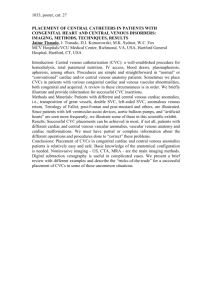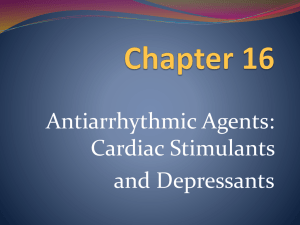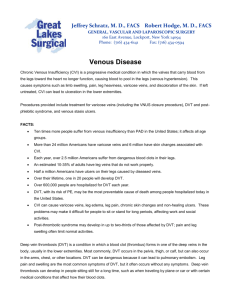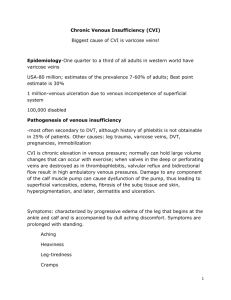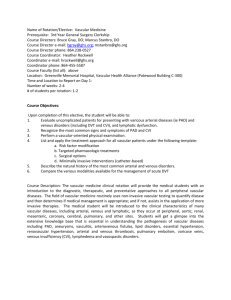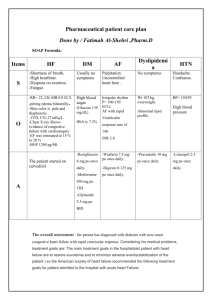Chapter 30: Nursing Management: Heart Failure
advertisement
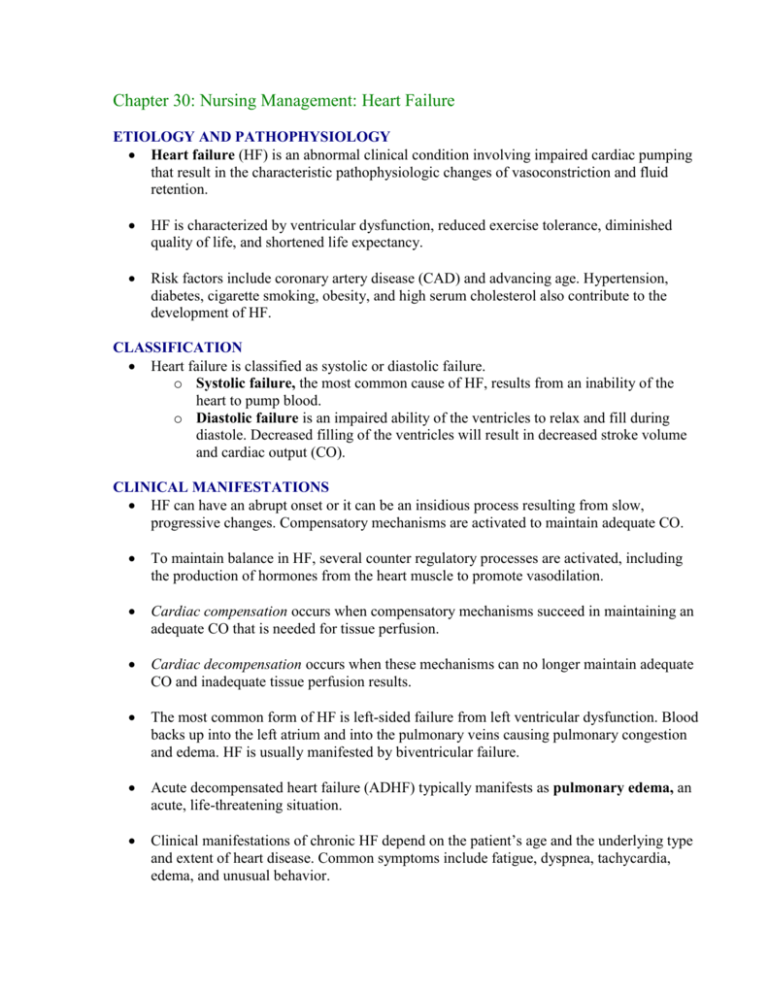
Chapter 30: Nursing Management: Heart Failure ETIOLOGY AND PATHOPHYSIOLOGY Heart failure (HF) is an abnormal clinical condition involving impaired cardiac pumping that result in the characteristic pathophysiologic changes of vasoconstriction and fluid retention. HF is characterized by ventricular dysfunction, reduced exercise tolerance, diminished quality of life, and shortened life expectancy. Risk factors include coronary artery disease (CAD) and advancing age. Hypertension, diabetes, cigarette smoking, obesity, and high serum cholesterol also contribute to the development of HF. CLASSIFICATION Heart failure is classified as systolic or diastolic failure. o Systolic failure, the most common cause of HF, results from an inability of the heart to pump blood. o Diastolic failure is an impaired ability of the ventricles to relax and fill during diastole. Decreased filling of the ventricles will result in decreased stroke volume and cardiac output (CO). CLINICAL MANIFESTATIONS HF can have an abrupt onset or it can be an insidious process resulting from slow, progressive changes. Compensatory mechanisms are activated to maintain adequate CO. To maintain balance in HF, several counter regulatory processes are activated, including the production of hormones from the heart muscle to promote vasodilation. Cardiac compensation occurs when compensatory mechanisms succeed in maintaining an adequate CO that is needed for tissue perfusion. Cardiac decompensation occurs when these mechanisms can no longer maintain adequate CO and inadequate tissue perfusion results. The most common form of HF is left-sided failure from left ventricular dysfunction. Blood backs up into the left atrium and into the pulmonary veins causing pulmonary congestion and edema. HF is usually manifested by biventricular failure. Acute decompensated heart failure (ADHF) typically manifests as pulmonary edema, an acute, life-threatening situation. Clinical manifestations of chronic HF depend on the patient’s age and the underlying type and extent of heart disease. Common symptoms include fatigue, dyspnea, tachycardia, edema, and unusual behavior. Pleural effusion, atrial fibrillation, thrombus formation, renal insufficiency, and hepatomegaly are all complications of HF. DIAGNOSTIC STUDIES The primary goal in diagnosis of HF is to determine the underlying etiology of HF. o A thorough history, physical examination, chest x-ray, electrocardiogram (ECG), laboratory data (cardiac enzymes, b-type natriuretic protein (BNP), serum chemistries, liver function studies, thyroid function studies, and complete blood count), hemodynamic assessment, echocardiogram, stress testing, and cardiac catheterization are performed. The BNP level is a key diagnostic indicator of HF; high levels are a sign of high cardiac filling pressure and can aid in the diagnosis of HF BNP levels below 100 pg/mL indicate no heart failure BNP levels of 100-300 suggest heart failure is present BNP levels above 300 pg/mL indicate mild heart failure BNP levels above 600 pg/mL indicate moderate heart failure. BNP levels above 900 pg/mL indicate severe heart failure Assessment S&S Short of breath Dyspnea on exertion (DOE) Orthopnea Paroxysmal Nocturnal Dyspnea Cough Edema Weight gain Fatigue Chest Pain Pulmonary edema The failing side Right Side Left Side The right side is responsible for pumping blood through the heart to the lungs. If this side fails, fluid backs up into the rest of your body (legs, feet, liver, veins). Right-sided failure RV cannot eject sufficient amounts of blood, and blood backs up in the venous system. This results in peripheral edema, hepatomegaly, ascites, anorexia, nausea, weakness, and The left side of the heart is responsible for receiving fresh oxygenated blood from the lungs and pumping out to the rest of the body. If this side fails, fluid backs up into the lungs. Left-sided failure LV cannot pump blood effectively to the systemic circulation. Pulmonary venous pressures increase, resulting in pulmonary congestion with dyspnea, cough (frothy sputum-pink-blood tinged), crackles, and impaired oxygen exchange. observe for effectiveness of therapy and for the patient’s ability to understand and implement self-management strategies. The nurse also explores the patient’s emotional response to the diagnosis of HF because it is a chronic and often progressive condition. Health History Focuses on the signs and symptoms such as dyspnea, shortness of breath, fatigue, and edema. Sleep disturbances, particularly sleep suddenly interrupted by shortness of breath, may be reported. Diagnosis Nursing Diagnoses Based on the assessment data, major nursing diagnoses for the patient with HF may include the following: • Activity intolerance and fatigue related to decreased CO • Excess fluid volume related to the HF syndrome • Anxiety related to breathlessness from inadequate oxygenation • Powerlessness related to chronic illness and hospitalizations • Ineffective therapeutic regimen management related to lack of knowledge Collaborative Problems/Potential Complications Based on the assessment data, potential complications that may develop include the following: • Hypotension, poor perfusion, and cardiogenic shock • Dysrhythmias (see Chapter 27) • Thromboembolism (see Chapter 31) • Pericardial effusion and cardiac tamponade (see Chapter 29) Planning and Goals Promote activity and reducing fatigue, relieving fluid overload symptoms, decreasing anxiety or increasing the patient’s ability to manage anxiety, encouraging the patient to verbalize his or her ability to make decisions and influence outcomes, and teaching the patient about the self-care program. Nursing Interventions Monitoring and Managing Potential Complications Promoting Home and Community-Based Care TEACHING PATIENTS SELF-CARE. Evaluation/ Expected Patient Outcomes 1. Demonstrates tolerance for increased activity a. Describes adaptive methods for usual activities b. Schedules activities to conserve energy and reduce fatigue and dyspnea c. Maintains heart rate, blood pressure, respiratory rate, and pulse oximetry within the targeted range 2. Maintains fluid balance a. Exhibits decreased peripheral and sacral edema b. Demonstrates methods for preventing edema 3. Is less anxious a. Avoids situations that produce stress b. Sleeps comfortably at night c. Reports decreased stress and anxiety d. Denies symptoms of depression 4. Makes sound decisions regarding care and treatment a. Demonstrates ability to influence outcomes 5. Adheres to self-care regimen a. Performs and records daily weights b. Ensures dietary intake includes no more than 2 to 3 g of sodium per day c. Takes medications as prescribed d. Reports any unusual symptoms or side effects NURSING AND COLLABORATIVE MANAGEMENT: ADHF AND PULMONARY EDEMA Treatment strategies should include the following: • Eliminate or reduce any etiologic contributory factors, such as uncontrolled hypertension or atrial fibrillation with a rapid ventricular response • Optimize pharmacologic and other therapeutic regimens • Reduce the workload on the heart by reducing preload and afterload • Promote a lifestyle conducive to cardiac health • Prevent episodes of acute decompensated HF oral and IV medications, major lifestyle changes, supplemental oxygen, implantation of assistive devices, and surgical approaches, including cardiac transplantation. Lifestyle recommendations include restriction of dietary sodium; avoidance of excessive fluid intake, alcohol, and smoking; weight reduction when indicated; and regular exercise. The patient must know how to recognize signs and symptoms that need to be reported to a health care professional. o Gas exchange is improved by the administration of IV morphine sulfate and supplemental oxygen. o Inotropic therapy and hemodynamic monitoring may be needed in patients who do not respond to conventional pharmacotherapy (e.g., diuretics, vasodilators, morphine sulfate). o Reduction of anxiety is an important nursing function, since anxiety may increase the SNS response and further increase myocardial workload. COLLABORATIVE CARE: CHRONIC HEART FAILURE The main goal in the treatment of chronic HF is to treat the underlying cause and contributing factors, maximize CO, provide treatment to alleviate symptoms, improve ventricular function, improve quality of life, preserve target organ function, and improve mortality and morbidity. Administration of oxygen improves saturation and assists greatly in meeting tissue oxygen needs and helps relieve dyspnea and fatigue. Physical and emotional rest allows the patient to conserve energy and decreases the need for additional oxygen. The degree of rest recommended depends on the severity of HF. General therapeutic objectives for drug management of chronic HF include: (1) identification of the type of HF and underlying causes, (2) correction of sodium and water retention and volume overload, (3) reduction of cardiac workload, (4) improvement of myocardial contractility, and (5) control of precipitating and complicating factors. o Diuretics are used in HF to mobilize edematous fluid, reduce pulmonary venous pressure, and reduce preload. Thiazide diuretics may be the first choice in chronic HF because of their convenience, safety, low cost, and effectiveness. They are particularly useful in treating edema secondary to HF and in controlling hypertension. Loop diuretics are potent diuretics. These drugs act on the ascending loop of Henle to promote sodium, chloride, and water excretion. Problems in using loop diuretics include reduction in serum potassium levels, ototoxicity, and possible allergic reaction in the patient who is sensitive to sulfa-type drugs. Spironolactone (Aldactone) is an inexpensive, potassium-sparing diuretic that promotes sodium and water excretion but blocks potassium excretion. This aldosterone receptor antagonist also blocks the harmful neurohormonal effects of aldosterone on the heart blood vessels. Spironolactone adds to the benefits of angiotensin-converting enzyme (ACE) inhibitors, and is appropriate to use while renal function is adequate. Spironolactone may also be used in conjunction with other diuretics, such as furosemide. Many potential problems associated with HF therapy relate to the use of diuretics: • Excessive and repeated diuresis can lead to hypokalemia (ie, potassium depletion). Signs include ventricular dysrhythmias, hypotension, muscle weakness, and generalized weakness. Hypokalemia poses problems for the patient with HF because it markedly weakens cardiac contractions. In patients receiving digoxin, hypokalemia can lead to digitalis toxicity. Digitalis toxicity and hypokalemia increase the likelihood of dangerous dysrhythmias (see Chart 30-3). Patients with HF may also develop low levels of magnesium, which can add to the risk of dysrhythmias. • Hyperkalemia may occur, especially with the use of ACE inhibitors, ARBs, or spironolactone. • Prolonged diuretic therapy may produce hyponatremia (deficiency of sodium in the blood), which results in disorientation, apprehension, weakness, fatigue, malaise, and muscle cramps. • Volume depletion from excessive fluid loss may lead to dehydration and hypotension. ACE inhibitors and betablockers may contribute to the hypotension. • Other problems associated with diuretics include increased serum creatinine and hyperuricemia (excessive uric acid in the blood), which leads to gout. Vasodilator drugs have been shown to improve survival in HF. The goals of vasodilator therapy in the treatment of HF include (1) increasing venous capacity, (2) improving EF through improved ventricular contraction, (3) slowing the process of ventricular dysfunction, (4) decreasing heart size, (5) avoiding stimulation of the neurohormonal responses initiated by the compensatory mechanisms of HF, and (6) enhancing neurohormonal blockade. ACE inhibitors (e.g., captopril [Capoten], benazepril [Lotensin], enalapril [Vasotec]) are useful in both systolic and diastolic HF, and they are the first-line therapy in the treatment of chronic HF. Angiotensin II receptor blockers (e.g., losartan [Cozaar], valsartan [Diovan]) may be used in patients who are ACE inhibitor intolerant. -Adrenergic blockers, specifically carvedilol (Coreg) and metoprolol (Toprol-XL), have improved survival of patients with HF. Positive inotropic agents improve cardiac contractility and CO, decrease LV diastolic pressure, and decrease SVR. Digitalis glycosides [e.g., digoxin (Lanoxin)] remain the mainstay in the treatment of HF, however, they have not been shown to prolong life. o Diet education and weight management are critical to the patient’s control of chronic HF. Diet and weight management recommendations must be individualized and culturally sensitive if the necessary changes are to be realized. A detailed diet history should be obtained and should include the sociocultural value of food to the patient. The Dietary Approaches to Stop Hypertension (DASH) diet is effective as a first-line therapy for many individuals with hypertension, and this diet is widely used for the patient with HF. The edema of chronic HF is often treated by dietary restriction of sodium. Fluid restrictions are not commonly prescribed for the patient with mild to moderate HF. However, in moderate to severe HF and renal insufficiency, fluid restrictions are usually implemented. Patients should weigh themselves daily to monitor fluid retention, as well as weight reduction. If a patient experiences a weight gain of 3 lb (1.4 kg) over 2 days or a 3- to 5-lb (2.3 kg) gain over a week, the primary care provider should be called. NURSING MANAGEMENT: CHRONIC HEART FAILURE The overall goals for the patient with HF include (1) a decrease in symptoms (e.g., shortness of breath, fatigue), (2) a decrease in peripheral edema, (3) an increase in exercise tolerance, (4) compliance with the medical regimen, and (5) no complications related to HF. Preventive care should focus on slowing the progression of the disease. o Patient teaching must include information on medications, diet, and exercise regimens. Exercise training (e.g., cardiac rehabilitation) does improve symptoms of chronic HF but is often underprescribed. o Home nursing care for follow-up care and to monitor the patient’s response to treatment may be required. Successful HF management is dependent on the following principles: (1) HF is a progressive disease, and treatment plans are established with quality-of-life goals; (2) symptom management is controlled by the patient with self-management tools (e.g., daily weights, drug regimens, diet and exercise plans); (3) salt and water must be restricted; (4) energy must be conserved; and (5) support systems are essential to the success of the entire treatment plan. Important nursing responsibilities in the care of a patient with HF include (1) teaching the patient about the physiologic changes that have occurred, (2) assisting the patient to adapt to both the physiologic and psychologic changes, and (3) integrating the patient and the patient’s family or support system in the overall care plan. o Patients with HF will take medication for the rest of their lives. This can become difficult because a patient may be asymptomatic when HF is under control. o Patients should be taught to evaluate the action of the prescribed drugs and to recognize the manifestations of drug toxicity. Patients should be taught how to take their pulse rate and to know under what circumstances drugs, especially digitalis and -adrenergic blockers, should be withheld and a health care provider consulted. It may be appropriate to instruct patients in home BP monitoring, especially for those HF patients with hypertension. Patients should be taught the symptoms of hypo- and hyperkalemia if diuretics that deplete or spare potassium are being taken. Frequently the patient who is taking thiazides or loop diuretics is given supplemental potassium. PHARMACOLOGY Digoxin Use and Toxicity in Heart Failure The therapeutic level of digoxin is usually 0.5 to 2.0 mg/mL. Blood samples are usually obtained and analyzed to determine digitalis concentration at least 6 to 10 hours after the last dose. Toxicity may occur despite normal serum levels, and recommended dosages vary considerably. Preparations Digoxin • Tablets: 0.125, 0.25, 0.5 mg (Lanoxin) • Capsules: 0.05, 0.1, 0.2 mg (Lanoxicaps) • Elixir: 0.05 mg/mL (Lanoxin Pediatric elixir) • Injection: 0.25 mg/mL, 0.1 mg/mL (Lanoxin) Digoxin Toxicity A serious complication of digoxin therapy is toxicity. Diagnosis of digoxin toxicity is based on the patient’s clinical symptoms, which include the following: • Anorexia, nausea, vomiting, fatigue, depression, and malaise (early effects of digitalis toxicity) • Changes in heart rate or rhythm; onset of irregular rhythm • ECG changes indicating SA or AV block; new onset of irregular rhythm indicating ventricular dysrhythmias; and atrial tachycardia with block, junctional tachycardia, and ventricular tachycardia Reversal of Toxicity Digoxin toxicity is treated by holding the medication while monitoring the patient’s symptoms and serum digoxin level. If the toxicity is severe, digoxin immune FAB (Digibind) may be prescribed. Digibind binds with digoxin and makes it unavailable for use. The Digibind dosage is based on the digoxin level and the patient’s weight. Serum digoxin values are not accurate for several days after administration of Digibind because they do not differentiate between bound and unbound digoxin. Because Digibind quickly decreases the amount of available digoxin, an increase in ventricular rate due to atrial fibrillation and worsening of symptoms of HF may ensue shortly after its administration. Nursing Considerations and Actions 1. Assess the patient’s clinical response to digoxin therapy by evaluating relief of symptoms such as dyspnea, orthopnea, crackles, hepatomegaly, and peripheral edema. 2. Monitor the patient for factors that increase the risk of toxicity: • Decreased potassium level (hypokalemia), which may be caused by diuretics. Hypokalemia increases the action of digoxin and predisposes patients to digoxin toxicity and dysrhythmias. • Use of medications that enhance the effects of digoxin, including oral antibiotics and cardiac drugs that slow AV conduction and can further decrease heart rate. • Impaired renal function, particularly in patients age 65 and older. Because digoxin is eliminated by the kidneys, renal function (serum creatinine) is monitored and doses of digoxin are adjusted accordingly. 3. Before administering digoxin, it is standard nursing practice to assess apical heart rate. When the patient’s rhythm is atrial fibrillation and the heart rate is less than 60 bpm, or the rhythm becomes regular, the nurse may withhold the medication and notify the physician, because these signs indicate the development of AV conduction block. Although withholding digoxin is a common practice, the medication does not need to be withheld for a heart rate of less than 60 bpm if the patient is in sinus rhythm because digoxin does not affect SA node automaticity. Measuring the PR interval for a patient with cardiac monitoring is more important than the apical pulse in determining whether digoxin should be held. 4. Monitor for gastrointestinal side effects: anorexia, nausea, vomiting, abdominal pain, and distention. 5. Monitor for neurologic side effects: headache, malaise, nightmares, forgetfulness, social withdrawal, depression, agitation, confusion, paranoia, hallucinations, decreased visual acuity, yellow or green halo around objects (especially lights), or “snowy” vision. Chapter 31: Nursing Management: Vascular Disorders PERIPHERAL ARTERIAL DISEASE Peripheral arterial disease (PAD) is a progressive narrowing and degeneration of the arteries of the neck, abdomen, and extremities. In most cases, it is a result of atherosclerosis. PAD typically appears in the sixth to eighth decades of life. It occurs at an earlier age in persons with diabetes mellitus and more frequently in African Americans. The four most significant risk factors for PAD are cigarette smoking (most important), hyperlipidemia, hypertension, and diabetes mellitus. The most common locations for PAD are the coronary arteries, carotid arteries, aortic bifurcation, iliac and common femoral arteries, profunda femoris artery, superficial femoral artery, and distal popliteal artery. PERIPHERAL ARTERIAL DISEASE OF THE LOWER EXTREMITIES PAD of the lower extremities affects the aortoiliac, femoral, popliteal, tibial, or peroneal arteries. The classic symptom of PAD of the lower extremities is intermittent claudication, which is defined as ischemic muscle ache or pain that is precipitated by a consistent level of exercise, resolves within 10 minutes or less with rest, and is reproducible. Paresthesia, manifested as numbness or tingling in the toes or feet, may result from nerve tissue ischemia. Gradually diminishing perfusion to neurons produces loss of both pressure and deep pain sensations. Physical findings include thin, shiny, and taut skin; loss of hair on the lower legs; diminished or absent pedal, popliteal, or femoral pulses; pallor or blanching of the foot in response to leg elevation (elevation pallor); and reactive hyperemia (redness of the foot) when the limb is in a dependent position (dependent rubor). Rest pain most often occurs in the forefoot or toes, is aggravated by limb elevation, and occurs when there is insufficient blood flow to maintain basic metabolic requirements of the tissues and nerves of the distal extremity. Complications of PAD include non healing ulcers over bony prominences on the toes, feet, and lower leg, and gangrene. Amputation may be required if blood flow is not restored. Tests used to diagnose PAD include Doppler ultrasound with segmental blood pressures at the thigh, below the knee, and at ankle level. A falloff in segmental BP of more than 30 mm Hg indicates PAD. Angiography is used to delineate the location and extent of the disease process. The first treatment goal is to aggressively modify all cardiovascular risk factors in all patients with PAD, with smoking cessation a priority. Drug therapy includes antiplatelet agents and ACE inhibitors. Two drugs are approved to treat intermittent claudication, pentoxifylline (Trental) and cilostazol (Pletal). The primary nonpharmacologic treatment for claudication is a formal exercise-training program with walking being the most effective exercise. Ginkgo biloba has been found to increase walking distance for patients with intermittent claudication. Critical limb ischemia is a chronic condition characterized by ischemic rest pain, arterial leg ulcers, and/or gangrene of the leg due to advanced PAD. Interventional radiologic procedures for PAD include percutaneous transluminal balloon angioplasty. There is a relatively high rate of restenosis after balloon angioplasty. The most common surgical procedure for PAD is a peripheral arterial bypass operation with autogenous vein or synthetic graft material to bypass or carry blood around the lesion. The overall goals for the patient with lower extremity PAD include (1) adequate tissue perfusion, (2) relief of pain, (3) increased exercise tolerance, and (4) intact, healthy skin on extremities. After surgical or radiologic intervention, the operative extremity should be checked every 15 minutes initially and then hourly for skin color and temperature, capillary refill, presence of peripheral pulses, and sensation and movement of the extremity. All patients with PAD should be taught the importance of meticulous foot care to prevent injury. Acute arterial ischemia is a sudden interruption in the arterial blood supply to tissue, an organ, or an extremity that, if left untreated, can result in tissue death. Signs and symptoms of an acute arterial ischemia usually have an abrupt onset and include the “six Ps:” pain, pallor, pulselessness, paresthesia, paralysis, and poikilothermia (adaptation of the ischemic limb to its environmental temperature, most often cool). Treatment options include anticoagulation, thrombolysis, embolectomy, surgical revascularization, or amputation. VENOUS THROMBOSIS Venous thrombosis is the most common disorder of the veins and involves the formation of a thrombus (clot) in association with inflammation of the vein. Superficial thrombophlebitis occurs in about 65% of all patients receiving IV therapy and is of minor significance. Deep vein thrombosis (DVT) involves a thrombus in a deep vein, most commonly the iliac and femoral veins, and can result in embolization of thrombi to the lungs. Three important factors (called Virchow’s triad) in the etiology of venous thrombosis are (1) venous stasis, (2) damage of the endothelium, and (3) hypercoagulability of the blood. Superficial thrombophlebitis presents as a palpable, firm, subcutaneous cordlike vein. The area surrounding the vein may be tender to the touch, reddened, and warm. A mild systemic temperature elevation and leukocytosis may be present. o Treatment of superficial thrombophlebitis includes elevating the affected extremity to promote venous return and decrease the edema and applying warm, moist heat. o Mild oral analgesics such as acetaminophen or aspirin are used to relieve pain. The patient with DVT may or may not have unilateral leg edema, extremity pain, warm skin, erythema, and a systemic temperature greater than 100.4 F (38 C). The most serious complications of DVT are pulmonary embolism (PE) and chronic venous insufficiency. Chronic venous insufficiency (CVI) results from valvular destruction, allowing retrograde flow of venous blood. Interventions for patients at risk for DVT include early mobilization of surgical patients. Patients on bed rest need to be instructed to change position, dorsiflex their feet, and rotate their ankles every 2 to 4 hours. The usual treatment of DVT in hospitalized patients involves bed rest, elevation of the extremity, and anticoagulation. Patients with hyperhomocysteinemia are treated with vitamins B6, B12, and folic acid to reduce homocysteine levels. The goal of anticoagulation therapy for DVT prophylaxis is to prevent DVT formation; the goals in the treatment of DVT are to prevent propagation of the clot, development of any new thrombi, and embolization. Indirect thrombin inhibitors include unfractionated heparin (UH) and low-molecular- weight heparin (LMWH). o UH affects both the intrinsic and common pathways of blood coagulation by way of the plasma cofactor antithrombin. o LMWH is derived from heparin and also acts via antithrombin, but has an increased affinity for inhibiting factor Xa. Direct thrombin inhibitors can be classified as hirudin derivatives or synthetic thrombin inhibitors. Hirudin binds specifically with thrombin, thereby directly inhibiting its function without causing plasma protein and platelet interactions. Factor Xa inhibitors inhibit factor Xa directly or indirectly, producing rapid anticoagulation. o Fondaparinux (Arixtra) is administered subcutaneously and is approved for DVT prevention in orthopedic patients and treatment of DVT and PE in hospitalized patients when administered in conjunction with warfarin. o Both direct thrombin inhibitors and factor Xa inhibitors have no antidote. For DVT prophylaxis, low-dose UH, LMWH, fondaparinux, or warfarin can be prescribed. o LMWH has replaced heparin as the anticoagulant of choice to prevent DVT for most surgical patients. o DVT prophylaxis typically lasts the duration of the hospitalization. o Patients undergoing major orthopedic surgery may be prescribed prophylaxis for up to 1 month postdischarge. Nursing diagnoses and collaborative problems for the patient with venous thrombosis can include the following: o Acute pain related to venous congestion, impaired venous return, and inflammation o Ineffective health maintenance related to lack of knowledge about the disorder and its treatment o Risk for impaired skin integrity related to altered peripheral tissue perfusion o Potential complication: bleeding related to anticoagulant therapy o Potential complication: pulmonary embolism related to embolization of thrombus, dehydration, and immobility The overall goals for the patient with venous thrombosis include (1) relief of pain, (2) decreased edema, (3) no skin ulceration, (4) no complications from anticoagulant therapy, and (5) no evidence of pulmonary emboli. o Depending on the anticoagulant prescribed, ACT, aPTT, INR, hemoglobin, hematocrit, platelet levels, and/or liver enzymes are monitored. o Platelet counts are monitored for patients receiving UH or LMWH to assess for HIT. o UH, warfarin, and direct thrombin inhibitors are titrated according to the results of clotting studies. o The nurse observes for signs of bleeding, including epistaxis, gingival bleeding, hematuria, and melena. Discharge teaching should focus on elimination of modifiable risk factors for DVT, the importance of compression stockings and monitoring of laboratory values, medication instructions, and guidelines for follow-up. o The patient and family should be taught about signs and symptoms of PE such as sudden onset of dyspnea, tachypnea, and pleuritic chest pain. o If the patient is on anticoagulant therapy, the patient and family need information on dosage, actions, and side effects, as well as the importance of routine blood tests and what symptoms to report to the health care provider. o Home monitoring devices are now available for testing of PT/INR. o Patients on LMWH will need to learn how to self-administer the drug or have a friend or family member administer it. o Patients on warfarin should be instructed to follow a consistent diet of foods containing vitamin K and to avoid any additional supplements that contain vitamin K. o Proper hydration is recommended to prevent additional hypercoagulability. o Exercise programs should be developed with an emphasis on walking, swimming, and wading. The expected outcomes for the patient with venous thrombosis include (1) minimal to no pain, (2) intact skin, (3) no signs of hemorrhage or occult bleeding, and (4) no signs of respiratory distress. CHRONIC VENOUS INSUFFICIENCY AND LEG ULCERS Chronic venous insufficiency (CVI) is a condition in which the valves in the veins are damaged, which results in retrograde venous blood flow, pooling of blood in the legs, and swelling. CVI often occurs as a result of previous episodes of DVT and can lead to venous leg ulcers. Causes of CVI include vein incompetence, deep vein obstruction, congenital venous malformation, AV fistula, and calf muscle failure. o Over time, the skin and subcutaneous tissue around the ankle are replaced by fibrous tissue, resulting in thick, hardened, contracted skin. o The skin of the lower leg is leathery, with a characteristic brownish or “brawny” appearance from the hemosiderin deposition. o Edema and eczema, or “stasis dermatitis,” are often present, and pruritus is a common complaint. Venous ulcers classically are located above the medial malleolus. o The wound margins are irregularly shaped, and the tissue is typically a ruddy color. o Ulcer drainage may be extensive, especially when the leg is edematous. o Pain is present and may be worse when the leg is in a dependent position. Compression is essential to the management of CVI, venous ulcer healing, and prevention of ulcer recurrence. o Options include elastic wraps, custom-fitted compression stockings, elastic tubular support bandages, a Velcro wrap, intermittent compression devices, a paste bandage with an elastic wrap, and multilayer (three or four) bandage systems. o Moist environment dressings are the mainstay of wound care and include transparent film dressings, hydrocolloids, hydrogels, foams, calcium alginates, impregnated gauze, gauze moistened with saline, and combination dressings. o Nutritional status and intake should be evaluated in a patient with a venous leg ulcer. o Routine prophylactic antibiotic therapy typically is not indicated. o Clinical signs of infection in a venous ulcer include change in quantity, color, or odor of the drainage; presence of pus; erythema of the wound edges; change in sensation around the wound; warmth around the wound; increased local pain, edema, or both; dark-colored granulation tissue; induration around the wound; delayed healing; and cellulitis. The usual treatment for infection is sharp debridement, wound excision, and systemic antibiotics. If the ulcer fails to respond to conservative therapy, alternative treatments may include use of a radiant heat bandage, vacuum-assisted closure therapy, and coverage with a split-thickness skin graft, cultured epithelial autograft, allograft, or bioengineered skin. o An herbal therapy used for the treatment of CVI is horse chestnut seed extract. Long-term management of venous leg ulcers should focus on teaching the patient about self-care measures because the incidence of recurrence is high. o Proper foot and leg care is essential to avoid additional trauma to the skin. o The patient with CVI with or without a venous ulcer is instructed to avoid standing or sitting with the feet dependent for long periods. o Venous ulcer patients are instructed to elevate their legs above the level of the heart to reduce edema. Once an ulcer is healed, a daily walking program is encouraged. Prescription compression stockings should be worn daily and replaced every 4 to 6 months to reduce the occurrence of CVI.
